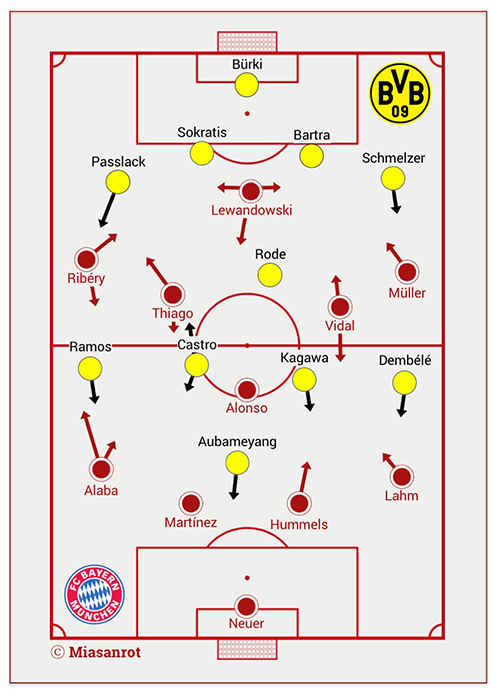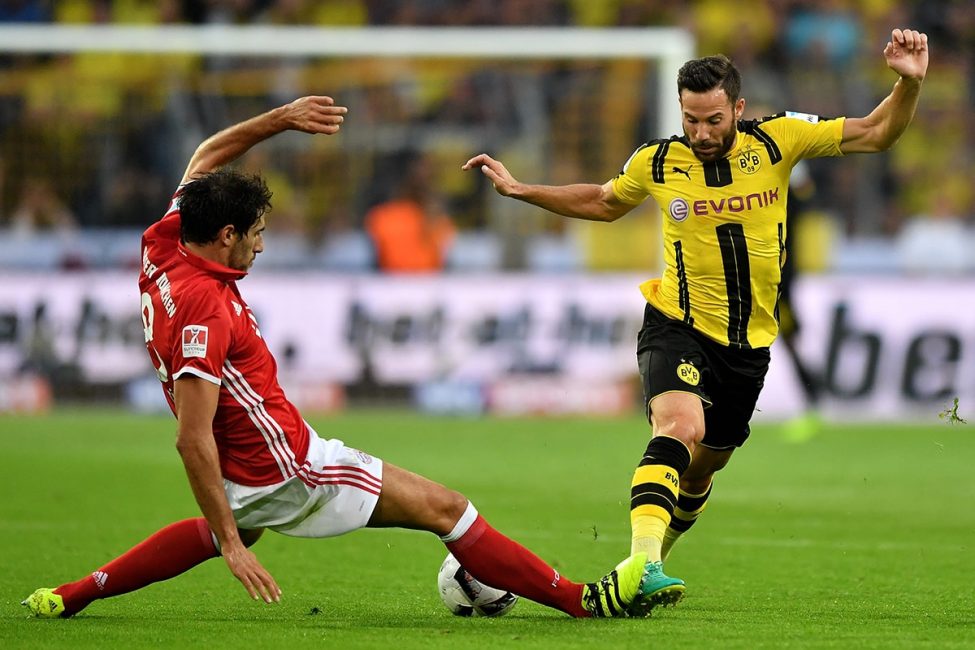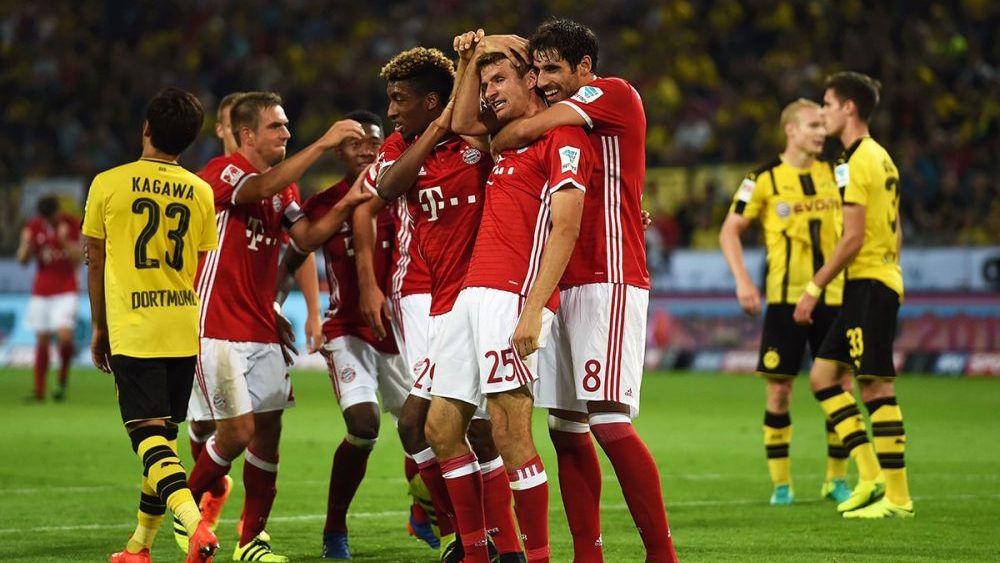Analysis: Borussia Dortmund – FC Bayern Munich 0-2 (0-0)
The two best German teams faced each other and the atmosphere was a little more tense than usual due to the three transfers between the two teams in the summer featuring Rode, Götze and Hummels. The line-ups didn’t look like preseason and both coaches showed their clear motivation to win the first trophy of the young season.
 DFL-Supercup 2016: Borussia Dortmund against FC Bayern Munich, starting formations
DFL-Supercup 2016: Borussia Dortmund against FC Bayern Munich, starting formations3 things we noticed:
1. Missing structure caused by missing rhythm?
Bayern didn’t get into their game in the first half. Manuel Neuer, Mats Hummels, Robert Lewandowski, Thomas Müller… the list of players who just returned from their vacation is long. That alone could be the reason why Dortmund was able to dominate the game and be the stronger team on the pitch. The host looked more coherent, quicker in their minds and was able to push the record champion into their own half time and time again.
In the end Borussia Dortmund possessed the ball for 51.9% of the game against the team of Carlo Ancelotti. When Bayern did have the ball, they were either overwhelmed by BVB’s pressing or lost the ball with easy turnovers. Despite Alonso frequently dropping back, there were no solutions for the build-up play in the first and second third of the pitch. The clear structure with the ball in Pep Guardiola’s positional play was hardly visible in this game. Vidal was often either too deep or too high up the pitch and Thiago often also moved very deep. But the Spaniard was the player who was able to get out of Dortmund’s pressing on multiple occasions. Mats Hummels also had trouble without a clear structure. He didn’t only have problems vertically, but also gave the impression as if the vacation is still not over yet. That’s totally understandable, because even a seasoned defender like him needs his time.

(Photo: Sascha Steinbach / Bongarts / Getty Images)
The helplessness with the ball was alarming. Bayern only managed to get in front of Bürki only once in the first half. It’s possible that Tuchel’s team is simply already in their rhythm and a step ahead, but two weeks before the Bundesliga kicks off Bayern’s performance was not enough.
Even if Ancelotti’s style of play is not focused on possession, it should be possible for the team to get some control over the game. That didn’t happen, because the opponent was very strong and individual and team tactics didn’t function properly. Especially the structural problems will (hopefully) give Carlo Ancelotti something to think about for the upcoming weeks. At least the second half gave the impression, that missing rhythm was the main reason for the weak performance.
2. Overloading and deep pressing
It was expected that Bayern would not play as risky against the ball as under Guardiola. Nevertheless it was surprising to see Dortmund have this much possession.
After Bayern didn’t get into the game in the beginning, they managed to gain some control over the game in the second half. BVB still had a lot of possession, but were not able to create dangerous situations as in the beginning of the game. The second half was a possible preview for the style Bayern could utilize against strong opponents in the future. Deep midfield pressing and a compact, hard to penetrate 4-4-2. That wasn’t pretty, but visibly unnerved the BVB offence.
It was very unusual to the record champion play that way and still holds the question, whether this style of play will continue to be successful. Dortmund had enough chances to go ahead in the first half, but this time they didn’t.
Also the game with the ball seems to get more predictable. Bayern create few chances, but use them very efficiently. Thiago holds an important role in the centre. The Spaniard escaped the pressing, actively participated in the build-up and also offered solutions in the final third. Furthermore it gets clearer that Alonso’s dropping back will become a constant again. As the first build-up player in the centre he tries to dictate the game, which didn’t always work out in Dortmund. Until now the most important element in Ancelotti’s game plan is the overloading of the flanks. In the DFL-Supercup it was the left side with Franck Ribery and later Kingsley Coman. Since there was only one 1vs1 player on the pitch, that made sense. When Lewandoski moved to the flanks, Müller moved into the centre. Out of these situations Bayern created their best chances.
With a second dribbler this approach could become more flexible in the upcoming weeks. Against BVB this was a little too predictable and stale.
3. Testing the waters
In the preview we talked about this game a first real test. This game showed that Dortmund’s preseason has been longer than Bayern’s. Clear structures, offensive flexibility and the amount of created chances painted a clear picture for the host. Bayern getting into the game and even being the better side after taking the lead was at least promising.
Despite the many problems there have also been some positive aspects. Manuel Neuer had a typical strong game. Neuer and Javi Martinez were the reasons for goalless draw at half-time. The Spaniard had a great game and didn’t only shine defensively, but also with his offensive input. The 27-year-old is often criticised for this build-up play. At least in the DFL-Supercup he showed that this isn’t completely true.
Thiago also confirmed the positive trend of the preseason games. He acts as a ball magnet, makes smart decisions, is probably the most pressing resistant player in the squad and also has strong moments against the ball. There is still some room for improvement concerning his offensive output, but currently he is a very important player for Bayern. Especially in the first weeks, when other players are still trying to find their rhythm, a strong Thiago is needed.
If one wants to use this game as a final test before the season, many issues can be reduced to the missing match practise. The structural problems are plain to see, but as the game progressed, Bayern took control of the game. It remains to be seen, whether the game without the ball against stronger teams makes sense or whether it played into Dortmund’s hand.
The final score speaks for this system, but with a little more quality in front of the goal the host could have sealed a win in the first half already.
| Borussia Dortmund – FC Bayern Munich 0-2 (0-0) | |
|---|---|
| Dortmund | Bürki – Passlack, Sokratis, Bartra, Schmelzer – Castro, Rode – Ramos (69. Weigl), Kagawa, Dembélé (68. Schürrle) – Aubameyang (78. Mor) |
| Bench | Weidenfeller, Götze, Guerreiro, Piszczek |
| FC Bayern | Neuer – Lahm, Martínez, Hummels, Alaba – Vidal (71. Kimmich), Alonso, Thiago – Müller (86. Rafinha), Lewandowski, Ribéry (65. Coman) |
| Bench | Ulreich, Bernat, Green, Feldhahn |
| Goals | 0-1 Vidal (58.), 0-2 Müller (79.) |
| Cards | Yellow: Passlack, Dembélé, Rode / Martínez, Ribéry, Alonso |
| Referee | Tobias Welz (Wiesbaden) |
| Attendance | 81,360 (sold out) |












This transitional period between Guardiola’s leadership and Ancelotti’s if full of uncertainty. Guardiola had such a strong vision of a Bayern team that would dominate through pass-possession and all that implies (superior positioning, off-the-ball movement, etc.), and one could see his active, analytical mind at work daily, tirelessly working to refine this dominant, attacking system of play.
Guardiola left some big shoes to fill, and even a man like Ancelotti must be a bit intimidated by the challenge of inheriting Guardiola’s team, trying to understand and sustain the best of what Pep had built, and maintaining the rhythm, focus and winning mentality of that system.
The danger here is that the transitional period, with the loss of such a dominant leader in Pep, is that the team loses focus and form – that there will be a sustained loss of form while the players and Ancelotti seek a new understanding of how to play.